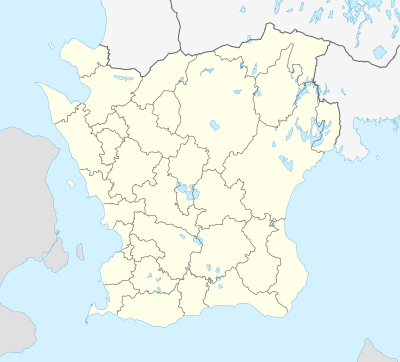Åhus
Åhus (Swedish pronunciation: [ˈôːhʉːs])[2] is the second largest locality in Kristianstad Municipality, Skåne County, Sweden with 9,423 inhabitants in 2010,[1] but the number triples during the summer due to tourists who come seeking the beaches and nature of the Helgeå and Hanöbukten area. Åhus is also famous for hosting one of the largest beach handball tournaments in the world with approximately 20,000 participants. In 2011, in the village of Rinkaby near Åhus, the World Scout Meeting also known as the Jamboree was held.
Åhus | |
|---|---|
Åhus, marketplace | |
 Åhus  Åhus | |
| Coordinates: 55°55′N 14°17′E | |
| Country | |
| Province | |
| County | Skåne County |
| Municipality | Kristianstad Municipality |
| Area | |
| • Total | 9.63 km2 (3.72 sq mi) |
| Population (31 December 2010)[1] | |
| • Total | 9,423 |
| • Density | 978/km2 (2,530/sq mi) |
| Time zone | UTC+1 (CET) |
| • Summer (DST) | UTC+2 (CEST) |
An old town, Åhus gained its city privileges in 1149, but lost them in 1617 when Kristianstad was built, following the burning of Vä by Swedish king Gustav II Adolf during the Kalmar War, 1611–13. Built during the 12th century, one of the oldest buildings of Åhus is Sankta Maria kyrka (church of St. Mary).
The town is also centre for the famous Swedish Eel-parties ("ålagille"), where people come together during August and September to eat smoked eel and drink considerable amounts of schnapps, preferably the world-famous Absolut Vodka that is produced in the town. Absolut Vodka is produced in Åhus, and is then exported to every corner of the world.
In 1950 an ice-cream factory was built in Åhus, Åhus Glass. The factory was bought by another company, and ice-cream is now made and sold under the name Ingman Glass. Today, the original owners of Åhus Glass have reopened under a new brand, Otto Glass, producing ice cream with the original Åhus Glass recipes — the company is famous for its chocolate-dipped waffle cones. Another ice cream factory in Skåne is Engelholms Glass.
References
- "Tätorternas landareal, folkmängd och invånare per km2 2005 och 2010" (in Swedish). Statistics Sweden. 14 December 2011. Archived from the original on 27 January 2012. Retrieved 10 January 2012.
- Jöran Sahlgren; Gösta Bergman (1979). Svenska ortnamn med uttalsuppgifter (in Swedish). p. 29.